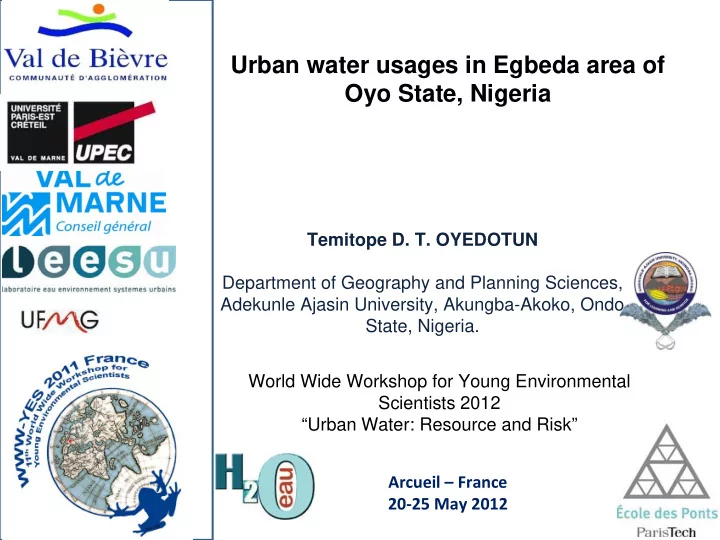

Urban water usages in Egbeda area of Oyo State, Nigeria Temitope D. T. OYEDOTUN Department of Geography and Planning Sciences, Adekunle Ajasin University, Akungba-Akoko, Ondo State, Nigeria. World Wide Workshop for Young Environmental Scientists 2012 “Urban Water: Resource and Risk” Arcueil – France 20 ‐ 25 May 2012
SNAP ‐ SHOTS One of the important components of any area is the development of water resources for various uses This work is aimed at evaluating water usage in communities within Egbeda LGA. Total surface water in Nigeria: 224 trillion litre/yr (Hanidu, 1990) Groundwater ‐ 50m trillion litre/yr (Akujieze et al., 2003) Abundant of fresh water resources in Nigeria, particularly in the south ‐ western region of the country River Omi 12th World Wide Workshop for Young Environmental Scientists
SNAP ‐ SHOTS UNDP ‐ Human Development Index placed Nigeria 159 among 177 countries assessed for unavailability of safe water and also among the 30 nations with poorest quality of life worldwide (Ifabiyi, 2012) In a nutshell, millions of Nigerians have no access to safe water and sanitation ‐ just like their fellows in other parts of the developing countries The water service level in urban cities in Nigeria have been bedevilled by ‐ breakdown of water infrastructural facilities ‐ geometric urban population increases as a result of rural ‐ urban migration influx and the high birth rates which have placed so much demand on the limited urban water infrastructural facilities River Omi 12th World Wide Workshop for Young Environmental Scientists
The Study Area Egbeda town is the current political headquarter of Egbeda Local Government Area (LGA) of Oyo State It is one of the 33 LGAs of the state The current population figure of Egbeda area at the 2006 Housing and Population Census is 281,573 (National Population Commission ‐ NPC, 2006) The earlier population figure of the community was 128,998 in 1991 Census. This indicates an increase of 54.2% in the total population within the space of 14 years 12th World Wide Workshop for Young Environmental Scientists
Materials and Methods A set of questionnaires was used to collect information from the communities on their water usages. The second methods adopted in the research involved the evaluation of the water samples from the different sources identified during the questionnaire administration. 12th World Wide Workshop for Young Environmental Scientists
Choice of water supply and use hand ‐ dug wells protected hand ‐ held boreholes Rivers, streams and unprotected springs are being utilised for car washing/laundry 12th World Wide Workshop for Young Environmental Scientists
Water Quality evaluation Ca 2+ , Mg 2+ , SO 4 2 ‐ , and Cl ‐ are far lesser than the WHO acceptable drinking water standards for the sampled water from the hand ‐ dug wells predominantly in all the three communities except for sodium (Na + ) and Iron in HDW 12th World Wide Workshop for Young Environmental Scientists
The Risk of the Resource Measured Acceptable Effect above/below level Parameters Level Cadmium 0.003 mg/l Kidney damage Chlorine Max 200mg/l Eye/nose irritation; stomach discomfort Calcium Max 200mg/l Indigestibility of fat in the body Magnesium Max 150mg/l Gastrointestinal, liver or kidney damage Iron 0.30 mg/l Rusting, cancer Sulphate Max 400 mg/l Allergic dermatitis Sodium Max 200 mg/l Increased risk of cancer The likely effect of water ingestion above/below acceptable level Source: WHO, 1997 12th World Wide Workshop for Young Environmental Scientists
Conclusion Nigeria was ranked as one of the Guinea ‐ worm infected countries in the last millenium (Akujieze, et al., 2003) Typhoid fever, cholera ‐ are prevalent in areas where people depend on streams, shallow uncovered wells, pools from drilling The groundwater quality is far below the acceptable WHO Drinking Water Standards Efforts will made to evaluate the other areas not covered and proper recommendation made to the Local and State Governments! Paying attention to the issue of our water today is the saving our lives tomorrow!!! 12th World Wide Workshop for Young Environmental Scientists
For listening and for your attentions, I say: Thank you!!! Thank you! 12th World Wide Workshop for Young Environmental Scientists
Recommend
More recommend